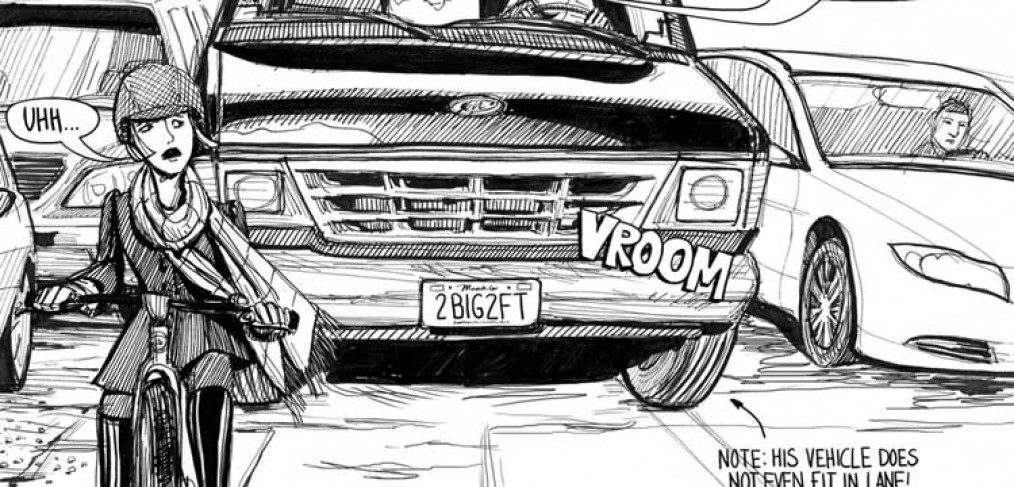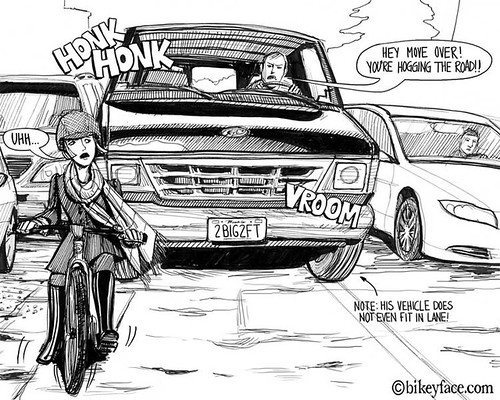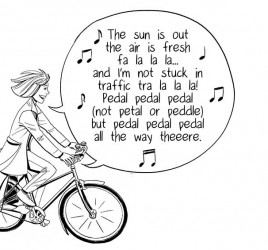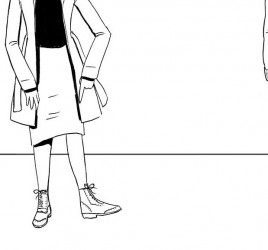
Not a Sideshow
I’ve been taking the lane more and more. In the beginning I was timid and concerned with being polite. However there are drivers who think- no matter what- bikes should be as far to the right as possible. No matter the door zone, pothole, debris, or gutter situation. They’re always eager to push bikes further off to the margins of the road. There have been many moments like this:
Which frequently resulted in large vehicles squeezing by me with mere inches to spare. But enough was enough- I got tired of being a sideshow act on the road. I take the full lane and stay safe. Of course that doesn’t stop the honking.





It’s really good that you’re taking the lane. That was some of the sage advice my mechanic gave me about riding downtown. It was certainly intimidating at the start, and I still get peeved when drivers give me a 3 foot buffer. Even worse are the angry folks that can’t understand why you’d ride a bike in traffic, as though you’re out for fun, not commuting home.
i know that it’s poor etiquette to shout back at them, but there are times that I really, REALLY want to yell back, “F*** you, read the law!”
I don’t know about Boston, but here in San Antonio bikes and cars are bound by the same laws.
Same in Boston and the whole state of Massachusetts.
Whoa! You nailed it with this post! It’s an everyday occurance for me as well, but I’m determined not to let them ruin my ride. I’ve found that taking the lane does minimize the close calls, but you’re correct that it doesn’t help with the honking.
I love the details in your drawings. The license plate on the truck in this one is just perfect.
I’ve been honked at, sworn at and was even shunted once, but I much prefer the potential perils of primary position to close passes and the door zone. A wave, a smile and a camera-phone at the next red light usually calms them down a bit.
Wonderful drawing.
Shunted? Not familiar with that term. Sounds not fun.
if I have time and plan accordingly, I’ll usually shoulder check and signal (usually by pointing down at the lane that I’m about to take … I have no idea if drivers actually interpret this correctly or not). That usually gives the aggressive jerks a chance to accelerate and pre-empt me to gain their precious 5 additional meters of imaginary progress before they hit the next red light. I’ll let them go and usually the next person is a little more gracious.
I’m also with cycler in that it certainly helps to have a bright rear-facing light.
At the risk of sounding needy, i have a request.
But first, loving your cartoons, and admire you greatly for commuting.
So, my quick tale, I live about 7 miles from work, to ride my bike involves a fast early morning descent to sea level, and then back up to 250 feet. In the middle of the that is a gated bridge that is open around 6 AM, and a mile on a side walk traveling opposite traffic. (This is the bike route, the side walk being “extra wide” for bikes). So the first 2 miles I freeze, then sweat to death climbing and then freaking out trying to cross side streets on a bike, on a sidewalk going the wrong way. Here in NY this time of the year it will be 15 degrees in the morning, and 45 in the afternoon.
And now, that awkward question of what are you wearing? I mean, what do you wear morning verse afternoon, and what times are you riding, and how far do you go. In other words, Could you share a few of your technical tips, as appalling as this may be for your blog, some of us are in awe and seek to emulate you.
Thanks for the cartoons, they are great and anyone that has ever ridding a bicycle knows EXACTLY what each on represents.
I don’t know that I have any technical tips really. It’s my 1st New England winter and I’m still figuring it out- especially since it’s been unusually warm. My route to work is about 4 miles and mostly flat. There hasn’t been much of a temperature difference in the morning vs. evening. My issue is that my office is heated to 80-90 degrees in winter so I go from deep winter to the peak of summer. Because it’s been in the 30-40’s outside so I’ve been wearing a wool sweater, light jacket, and scarf/gloves/hat most days with a dressy t-shirt underneath for work. Only lately have I changed to a normal coat but have found it way too warm most days. The coldest weather I’ve biked in was in the 20’s and I wore silk long underwear which was effective, but I have to take it off once I get to work which is slightly annoying. But they’re small and easy to tuck in a bag vs. heavy wind/rain/snow pants. I don’t know if this will become normal for me as it gets colder. We’ll see.
I’m still pretty green when it comes to cycling, but the ideal is that your energy expenditure should be static regardless of the terrain. It’s your *speed* that should be variable. If your energy expenditure is static, your temperature concerns should be minimal. The morning/afternoon difference is unavoidable, but that can be handled with a little bit of layering.
About the uphill/downhill problem, yes your energy output could be constant, but if your speed’s varying from 5mph to 20mph the cooling from the air passing you is going to go up by a factor of 16! [at least the drag will, and I’m guessing the cooling will too.] Downhill before you’re warmed up, uphill right before your destination is just hard to deal with. I hate stopping, but in this instance it might even be worth stopping and pulling off a hardshell after you’ve warmed up. For me I usually leave a middle layer in my bag for the generally warmer return trip. I keep the accessories similar, headband, facemask, different gloves for different temp ranges. My coldest weather gloves are nice old patagonia winter hiking gloves. In even colder weather I bust out the gauntlet mittens. And ski goggles. Leg layers are key… jeans+longjohns seem to work down to 40 [if no rain] but jeans+pvc rainpants work down lower, or Marmot precip zip-offs if I need to quick-change… but they’re not very waterproof anymore. Both hardshell pants + longjohns for the bitter cold days. Stuff that you can pull or compact while still riding, like a neoprene facemask or goggles or scarf/smartwool neck gaiter help with dealing with warming up underway. And zippers [both main & pit & pocket] in your softshell or hardshell can help too.
Dress for the warm part of the ride, if you have too much trouble stowing layers. You will not be cold for long and you will get used to it. That being said, clothes that wick, gloves and shoe covers that break the wind help an awful lot. I ride only slightly further, in only slightly less hilly terrain (down one river bluff and up another). Fortunately, trees and such help break the wind a good part of my trip.
I ride a fully faired machine and in the 10F to 12F degree range I dress as if I was on a conventional exposed bike in the upper 50’s. I carry extra clothes for the cold weather for when I need to stop and get out. My speeds are much faster than a conventional bike also.